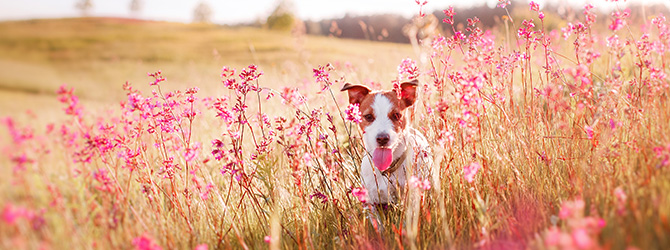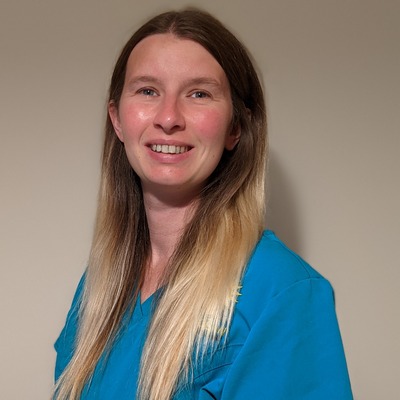8 poisonous plants for dogs to avoid
Spring may be a colourful time of year, but as the birds begin chirping and the flowers begin to blossom, your dog could be in danger if they come into contact with the wrong plant or flower.
Read on to see what plants are toxic to your dog and how to keep your pets safe.
Let’s take a look at 8 plants that are poisonous to dogs.
1. Buttercups
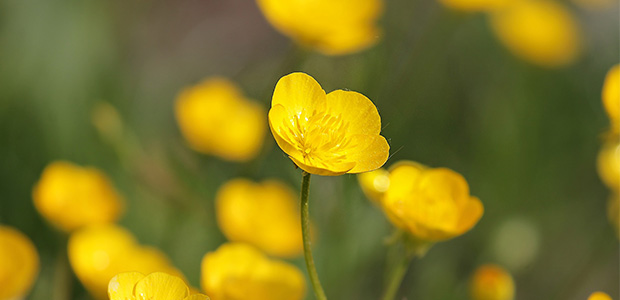
With their shiny yellow flowers, buttercups can be found in meadows and gardens throughout spring and summer. Unfortunately, they’re toxic to dogs. The toxicity comes from ranunculin, which becomes an irritant called protoanemonin when your dog chews or crushes it
- Drooling
- Vomiting
- Diarrhoea
- Abdominal pain
- Weakness
- Appear unusually quiet
- Reluctant to move due to discomfort.
Although rare, in severe cases, buttercup poisoning can lead to
- Convulsions
- Tremors
- Temporary paralysis
Because buttercups grow practically everywhere, from gardens to wild fields, watching your dog during walks where these flowers grow is important. Teaching them the ‘Leave’ command early in puppyhood can help ensure they don’t investigate these flowers too much.
Luckily, buttercups taste extremely bitter, so it’s rare for dogs to eat them. However, if you have buttercups in your garden, you could remove or fence them off the area to stop your dog from getting to them. Although they won’t generally taste nice, young, inquisitive puppies might still give them a nibble.
2. Daffodils

With their bold colours and beautiful shapes, daffodils tell the world that spring is coming. But did you know these popular flowers can be harmful to dogs?
The entire daffodil plant is toxic to dogs, but the bulbs contain the highest concentration of harmful alkaloids, including lycorine, which can cause significant health issues if swallowed.
When dogs come into contact with daffodils, either by nibbling on the leaves and flowers or digging up and chewing on the bulbs, they can experience symptoms, including:
- Excessive drooling
- Vomiting
- Diarrhoea
- Abdominal pain
- Rapid heart rate
- Difficulty breathing
- Convulsions
- Heart problems
If you have daffodils in your garden or are walking your dog in an area where these flowers grow, keep a close eye to ensure they don't chew on the plants. If you have daffodils indoors, keep them well out of reach. The bulbs can be appealing for dogs to roll around and play with, so store them well out of reach before planting.
3. Tulips

Tulips are a favourite among gardeners with their vibrant colours and elegant shapes. However, dog owners should know that tulips can pose a serious risk. The entire plant can be toxic to dogs, but the bulb is especially dangerous.
When a dog chews on or ingests tulip bulbs, they can be exposed to allergenic lactones and other toxic alkaloids, leading to various symptoms. These can range from mild to severe, depending on the amount of the plant ingested.
Early signs of tulip toxicity in dogs include:
In some cases, dogs may also experience depression, a significant increase in heart rate, and difficulty breathing.
Dogs are at risk of digging up and chewing on the bulbs because of their natural curiosity and the potential for tulips to be planted at nose or paw level. To protect your dog, it’s important to plant tulips in areas inaccessible to dogs, or try using physical barriers, such as fences or raised flower beds. Store bulbs well out of reach of curious noses and paws before planting.
4. Cyclamen

Cyclamen is a hardy perennial plant that's potentially harmful to your dog, and it flowers when other toxic plants are out of season. Flowering in late winter, many people love these as indoor plants, which means they're often within easy paw's reach. The roots, and tubers, contain the highest toxin concentrations, leading to symptoms such as:
- Excessive drooling
- Vomiting
- Diarrhoea
- Difficulty breathing
- Convulsions
- Heart problems
Keeping cyclamen plants in the home is possible, but it’s best to place them on high shelves or hanging planters, well beyond the reach of curious pets.
5. Oleander

While beautiful with its vibrant flowers and lush foliage, the oleander plant poses a significant risk to dogs. This plant contains several toxic compounds, including oleandrin and digitoxigenin, which are highly toxic cardiac glycosides. These compounds are incredibly dangerous to your pet's heart function and overall health. Symptoms include:
6. Azaleas
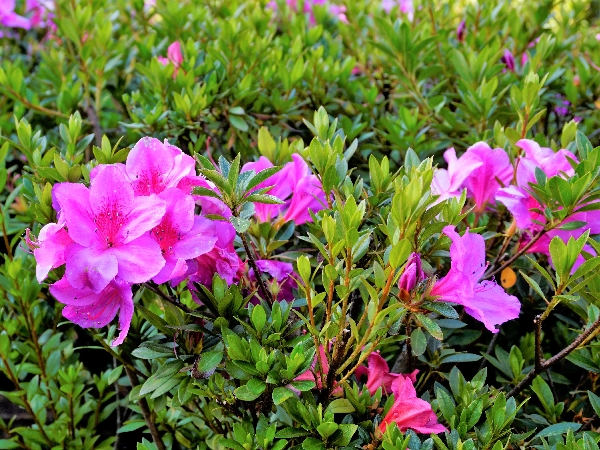
Azaleas are lovely to look at but not so good for your dog's health. Even a small amount of azalea plant ingested by your dog can cause a range of symptoms due to a highly potent toxin called grayanotoxin.
This toxin can lead to:
7. Sago palm
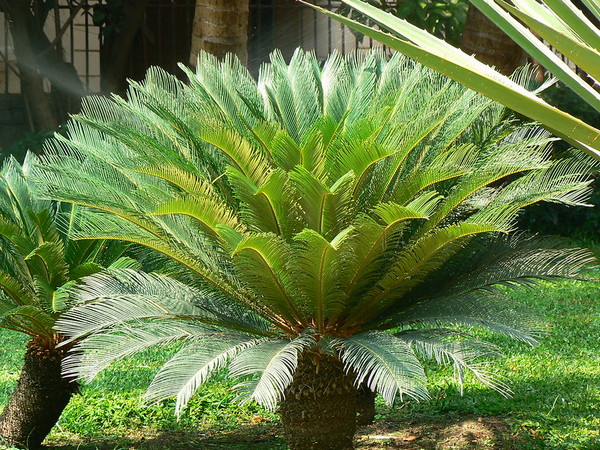
Image of Sago Palm - © Dinesh Valke. Photo by Dinesh Valke Source
While often admired for its exotic appearance and resilience, the sago palm’s whole plant — especially its seeds — is extremely poisonous to dogs.
The active toxin cycasin causes a severe upset in the gastrointestinal system, leading to symptoms like:
Liver damage can be severe, sometimes leading to death if not treated promptly. Given its potential for danger, it's best to avoid this plant entirely, but if you have to have it in your home, make sure it’s well out of reach from your dog and that any seeds or leaves cannot fall to the floor.
8. Foxglove

Image of Foxglove - © Peter O'Connor. Photo by Peter O'Connor Source
Found both in gardens and growing wild, foxgloves are well-loved in the UK, partly because they attract bees and other pollinators. However, they contain dangerous cardiac glycosides, primarily digitoxin and digoxin. Doctors use these compounds in medications to treat certain heart conditions, but they can be dangerous when swallowed in un-prescribed doses by animals or humans.
Symptoms of foxglove poisoning can include:
- Vomiting
- Diarrhoea
- Drooling
- Weakness
- Cardiac arrhythmias (irregular heartbeat)
- Collapse
- Changes in heart rate (either too slow or too fast)
- Lethargy
- Dilated pupils
- Seizures (in severe cases)
- Death (in severe cases)
The severity of symptoms can vary depending on the amount of foxglove swallowed. The cardiac effects can be particularly dangerous, leading to a significant alteration in heart rate and rhythm. This can result in a critical situation that requires immediate veterinary attention.
Prevention
Preventing dog poisoning from plants like foxglove, cyclamen, buttercups, tulips, daffodils, and other toxic varieties involves vigilance, education, and sometimes a bit of garden redesign.
Restrict access
For outdoor plants, consider fencing off areas of your garden where toxic plants are growing. Place indoor plants out of reach—on high shelves or in rooms your pet cannot access.
Choose pet-safe plants
Choose species that are safe for dogs when adding plants to your garden or home. For indoor plants, consider fake or plastic plants. They still look great and are poison-free.
Supervise outdoor time
Keep an eye on your dog when they’re outside, especially in areas where you know there are toxic plants. Discourage them from chewing on any plants or flowers.
Training
Teach your dog commands like ‘leave’ to prevent them from eating plants and other objects they shouldn’t. Always use positive reinforcement.
Remove or replace toxic plants
If possible, remove toxic plants from your garden or home. If you love gardening, consider replacing toxic plants with safer alternatives with similar visual appeal.
Create barriers
Use physical barriers like plant cages or decorative fences to protect your plants and prevent dogs from getting too close.
Regular inspection
Regularly inspect your garden and home for plants that might have been brought in unknowingly and could be toxic to your dog.
Know your plants
Use this article to understand which plants are toxic to dogs, and keep a list handy for quick reference.
Emergency plan
Have a plan in case of poisoning. Know the symptoms of plant poisoning in dogs, keep your vet's phone number handy, and be aware of the location of the nearest 24-hour veterinary clinic.
Need more information?
Read more about common dog poisons and cat poisons to stay away from here!
Find your nearest vet using our Find a Vet page, or speak to a vet online using Online Vets.
